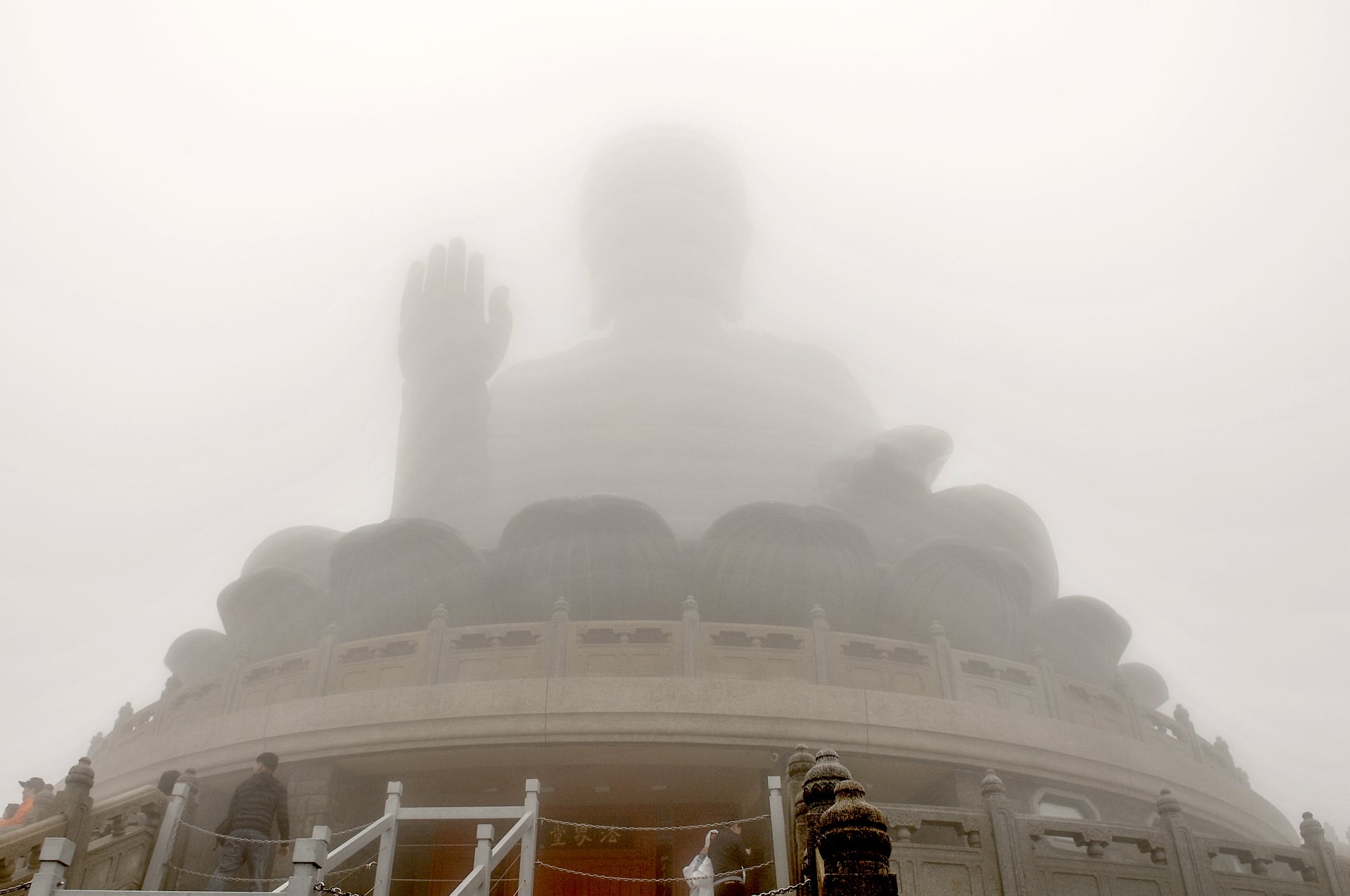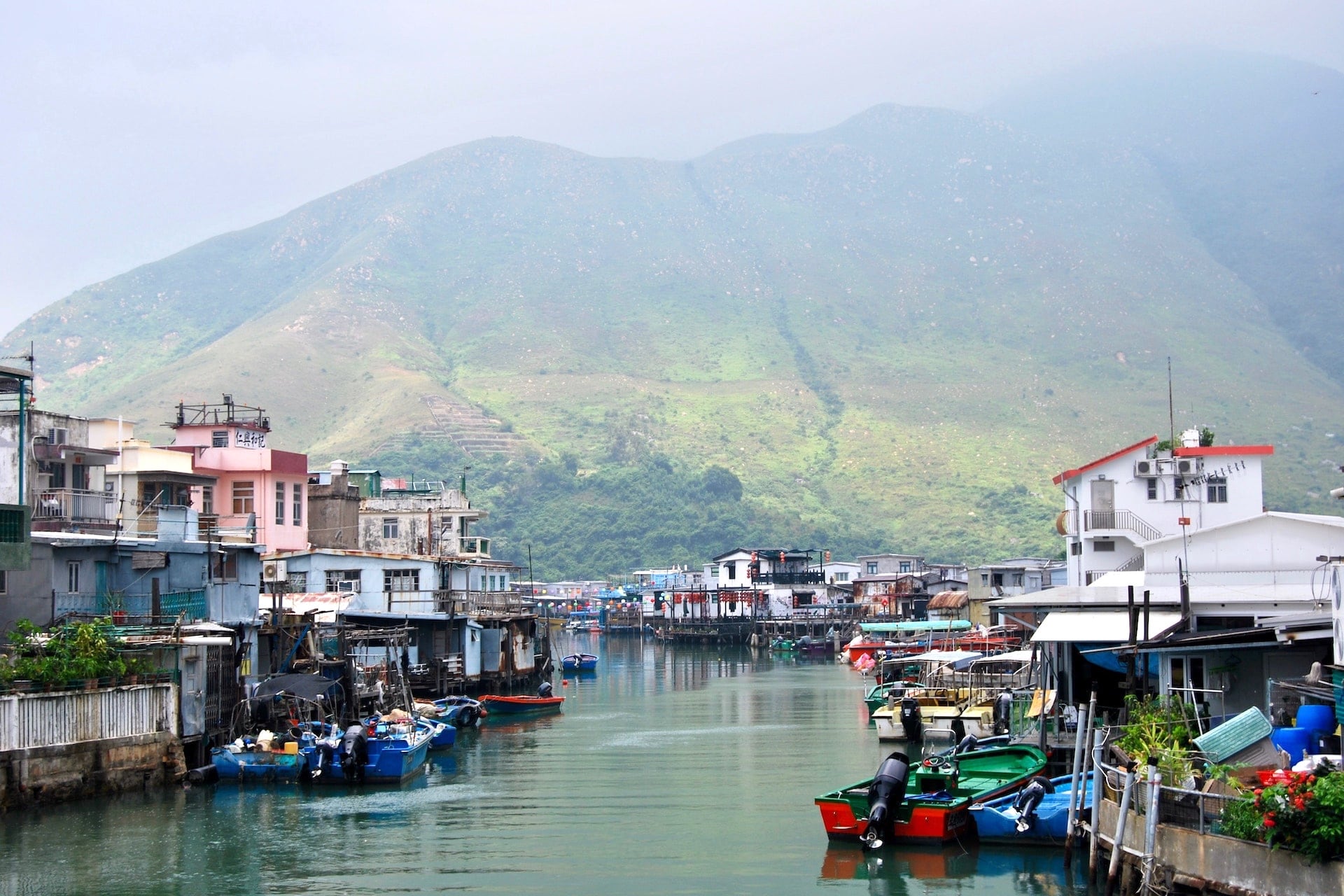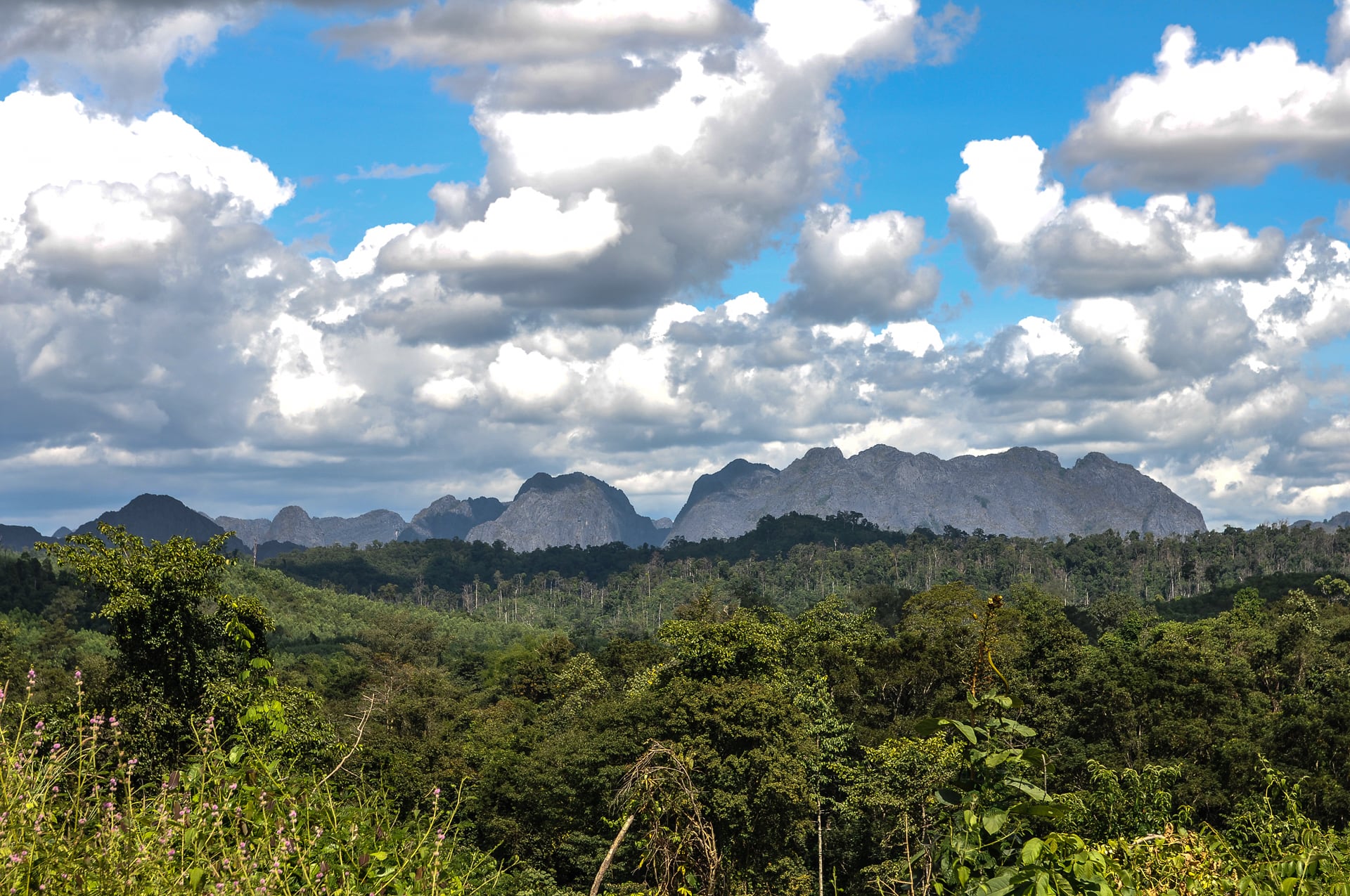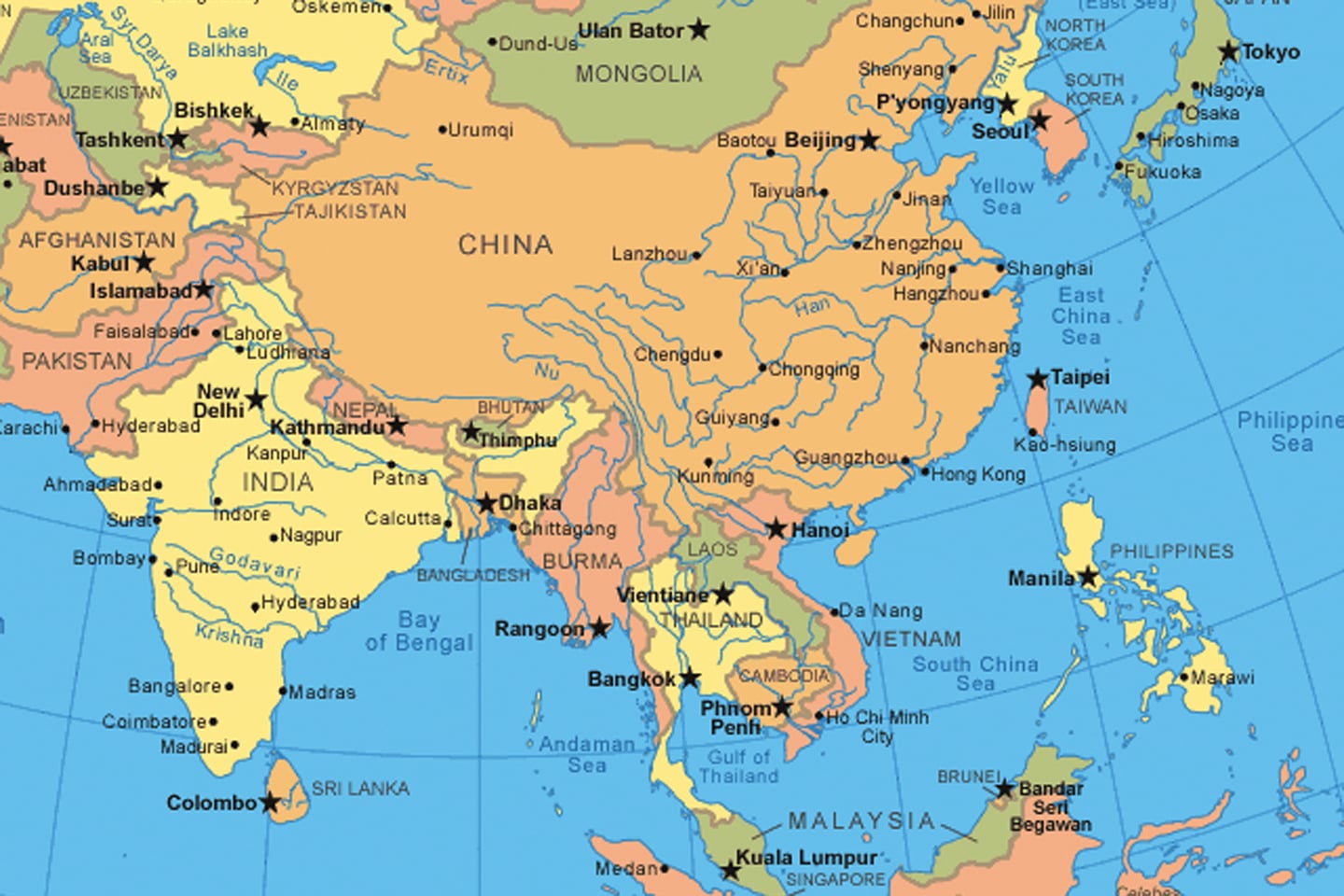The Big Buddha of Hong Kong is one of the largest seated Buddha images in the world and is a sight to behold.
It is a popular tourist attraction and source of pride for Hong Kong residents for what it represents spiritually, culturally, and from an artistic and engineering standpoint.
The statue, itself, is 34 meters tall (112 feet), and constructed of over 200 bronze pieces weighing in at over 250 metric tonnes. Visitors must ascend 268 steps to reach the base of the statue, which sits at 482 meters (1,581 feet) above sea level.
In addition, the Tian Tan statue is set on a prominence surrounded by dramatic scenery.
TIAN TAN BUDDHA QUICK FACTS
| Also Known As: | Tian Tan or 天壇大佛 |
| Location: | Ngong Ping Village, Lantau Island, Hong Kong |
| GPS: | N22°15’15.451″ E113°54’17.981″ |
| Height: | 34 meters (112 feet) |
| Year Constructed: | Began: 1990, Unveiled: 1993 |
| Stair Steps to Big Buddha: | 268 |
| Kid-Friendly?: | Yes! |
| Time Requirement: | 1-2 hours at Big Buddha complex; 4-6 hours on Lantau, including travel time from central Hong Kong. |
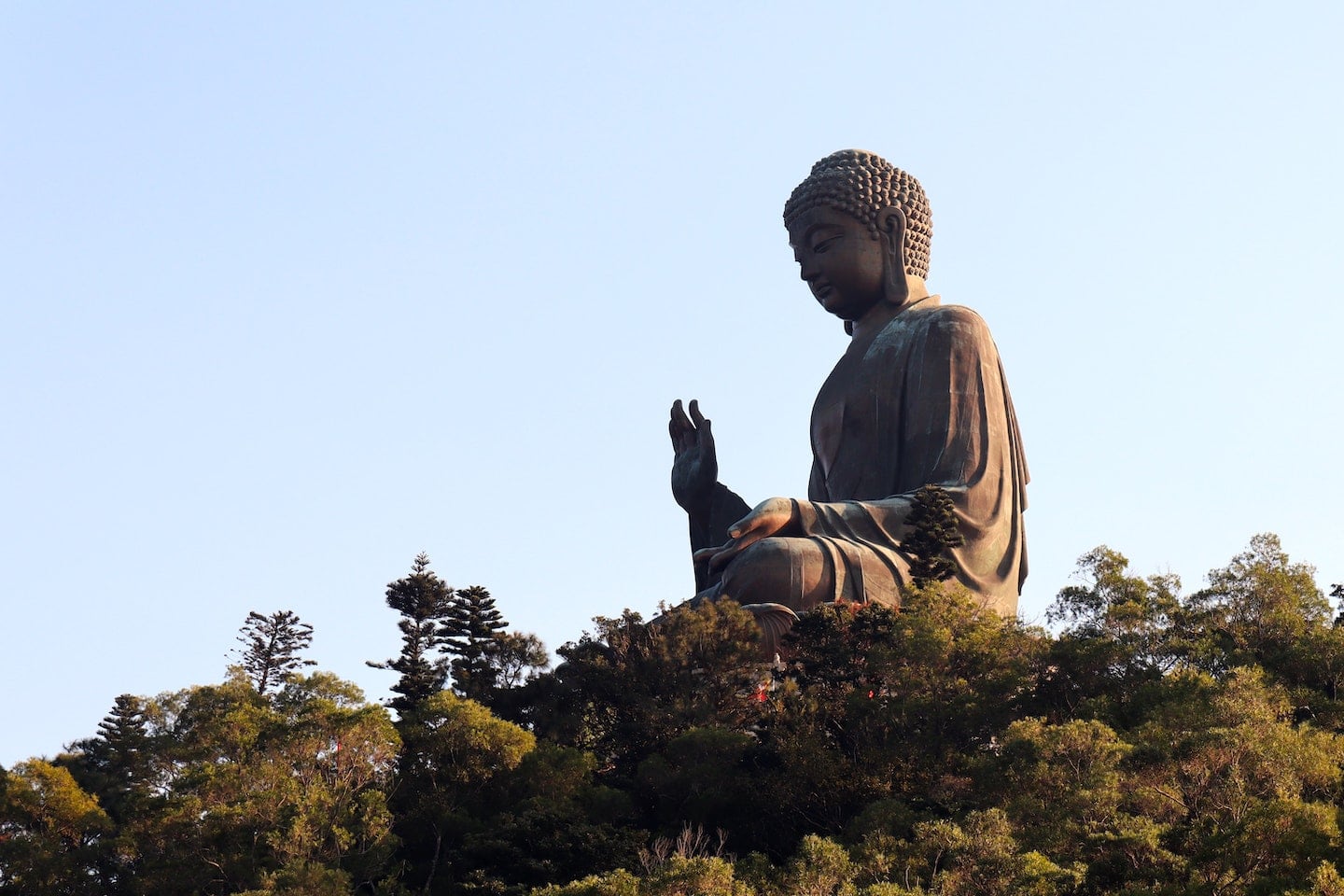
Visiting the Big Buddha makes a great day trip by itself, or coupled with a ride on the Ngong Ping Cable Car, visit to Po Lin Monastery, hiking the many scenic trails on Lantau, visiting historic Tai O fishing village, and many other activities.
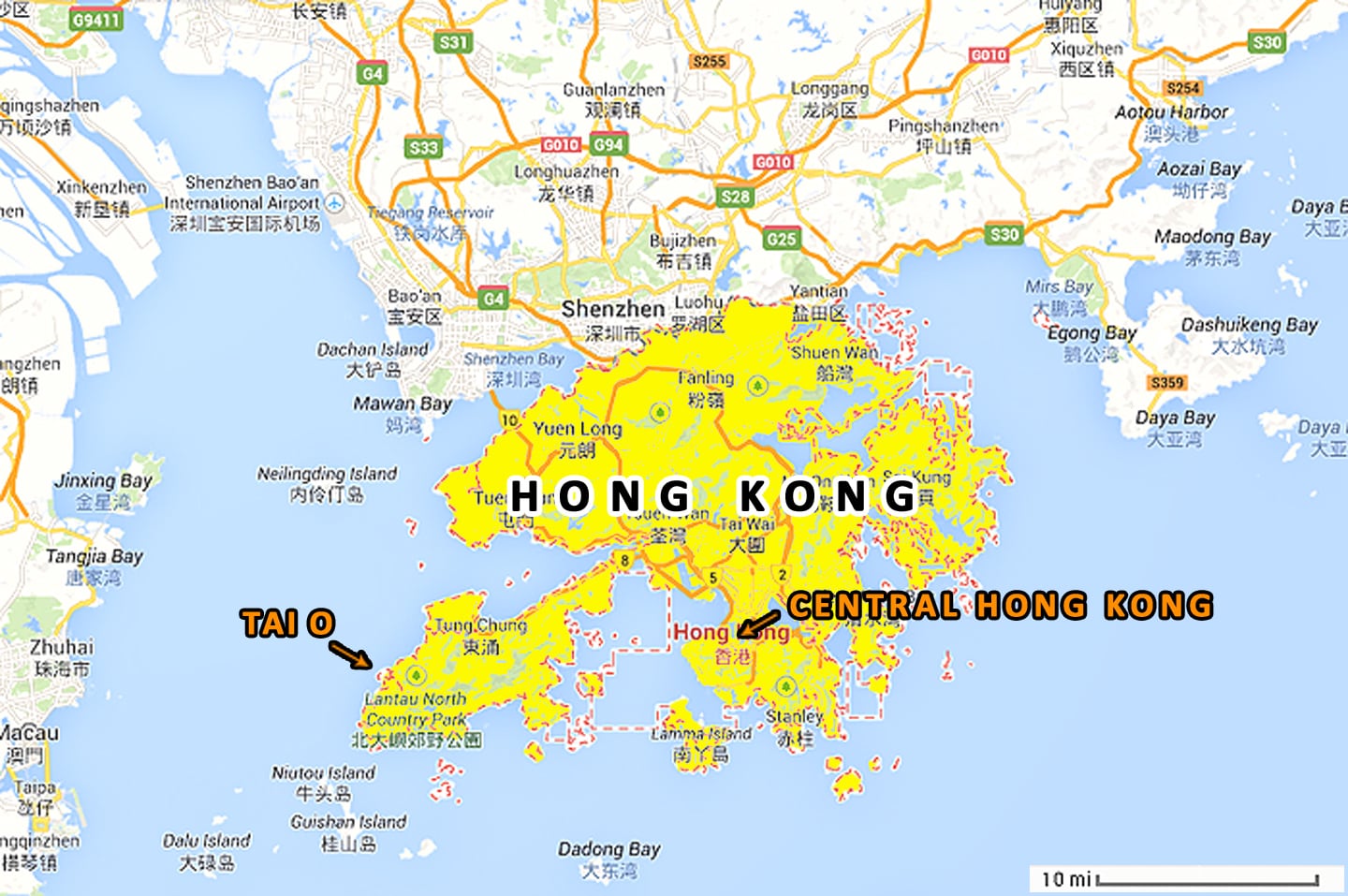
How to Get to the Tian Tan Buddha in Hong Kong
The Tian Tan Buddha is located about ten miles from central Hong Kong, as the crew flies. Fortunately, it is surprisingly easy to get between central Hong Kong and Lantau Island via the fast and efficient Metro or by taking advantage of Hong Kong’s extensive network of public ferries and buses.
The journey can made on your own with relative ease, or through a tour company. We highly recommend going the tour route if you are pressed for time, traveling with kids, or don’t want to worry about travel logistics.
Putting the Trip Together Yourself (DIY Option)
We recommend taking the New World First Ferry “Fast Ferry Service” from Central (Pier #6) to Mui Wo on the eastern shore of Lantau island.
The fast ferry takes about 40 minutes and costs HK$31 each (about US$4), one-way (Mar 2021). If you’re looking to get an even cheaper rate, NWFF also offers “Ordinary Ferry” service as well.

From Mui Wo on Lantau, catch the Bus No.2 up to the Big Buddha (Tian Tan Buddha). The journey costs around US$1.50 per person and takes about 90 minutes.
From Big Buddha, you can also catch an onward bus to other popular sites on Lantau island, such as Tai O fishing village, or return to the ferry pier in Mui Wo.
Alternatively, you can use the MTR (Metro/subway) to get between Hong Kong and Lantau Island (though we recommend taking the ferry at least one of the directions for the views and experience).
Hop on the MTR Tung Chun line at Hong Kong or Kowloon station and take it all the way to Tung Chung (about US$5). You could also take the Airport Express line, but you would need to change to the Tung Chung line at Tsing Yi.
From Tung Chun station you have four main options: Take Bus No.23 or No.11, take a taxi, or hike, or ride the Ngong Ping Cable Car.
If you choose to hike from Tung Chun station to Big Buddha, you can pick up the trail right at the station.
Ngong Ping 360 Cable Car
The recent addition of the Ngong Ping Cable Car has added another way to get to the Big Buddha. Billed as the quickest and most direct route to the Tian Tan Buddha, the cable car run from the MTR Tung Chung station, up and over Tung Chung Bay and the hills of Lantau, to within 1 km of the base of the statue.
Lines for the cable car can be horrendously long, so it’s best to get your cable car tickets in advance, which can be done online or at many large international hotels in the area.
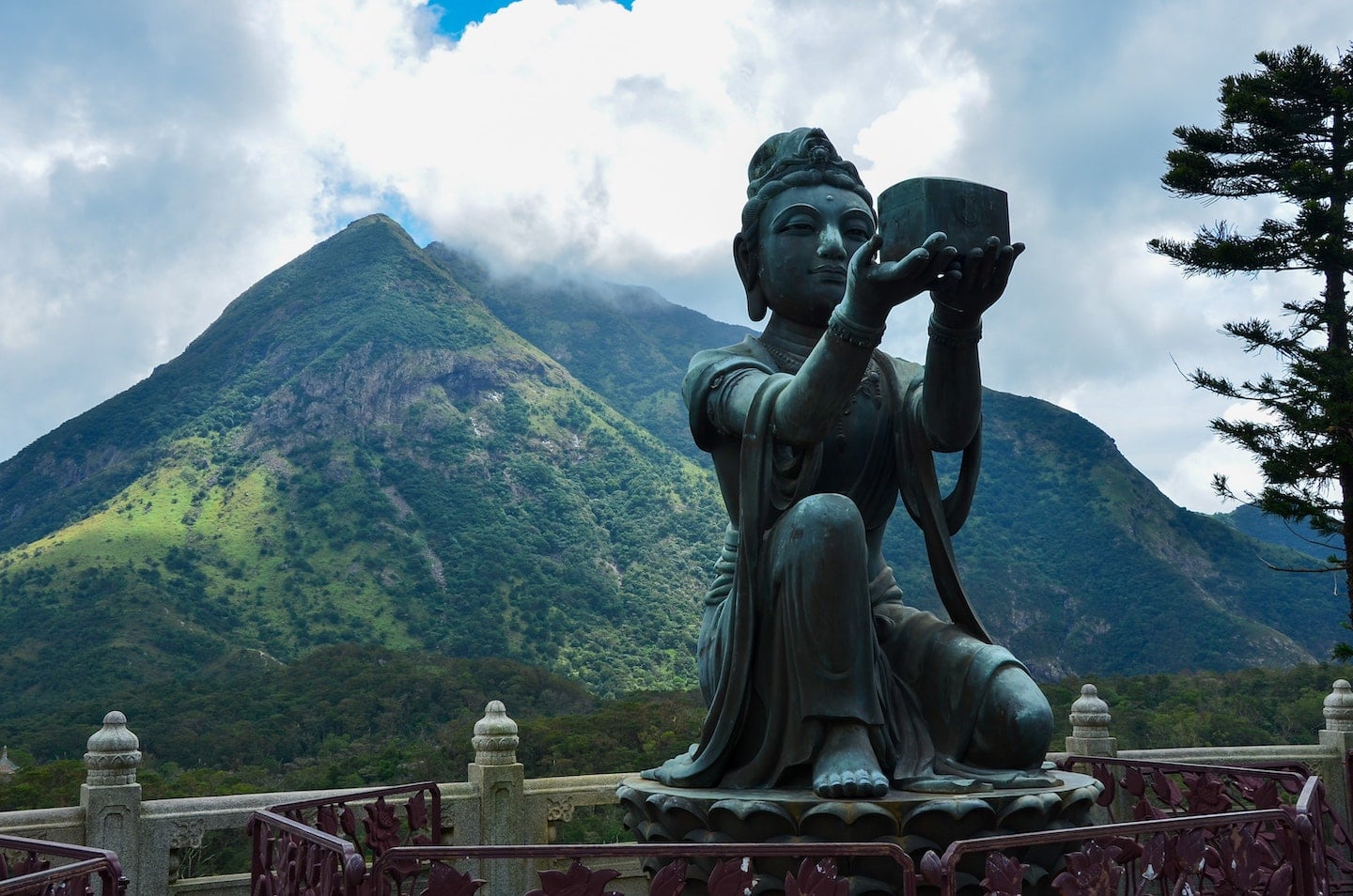
When to Visit the Big Buddha
The best time of year to visit Hong Kong, in general, is September to mid-December, when temperatures are comfortable and humidity is low.
December and January tend to be the driest months, but the weather can also get a bit chilly during that time. For those who prefer dry conditions, it’s best to avoid the rainy season, which usually occurs from May through September.
With regards to visiting the Hong Kong Big Buddha, keep in mind that fog is a common occurrence (see our trip report below), given the coastal location and Ngong Ping’s higher elevation.
No doubt, Tian Tan can still be enjoyed on a foggy day. But if you want to be able to get the most out of your visit and be able to take in the incredible scenery, be sure to keep a flexible itinerary and check reliable weather reports.
Taking a look at live weather cams before heading to Lantau may help in planning your visit. But do keep in mind that weather is highly changeable in some parts of the year, and it can be clear at the airport but fogged in at 482 meters above sea level.
Our advice is, if the forecast calls for any chance of fog, skip the Cable Car. The lines can be long no matter what the weather, and there’s not a whole lot you can see up in the Cable Car on a foggy day.
In terms of avoiding the crowds, the same goes for most top attractions. Try to visit as early in the day as possible, midweek, and or in the off season.
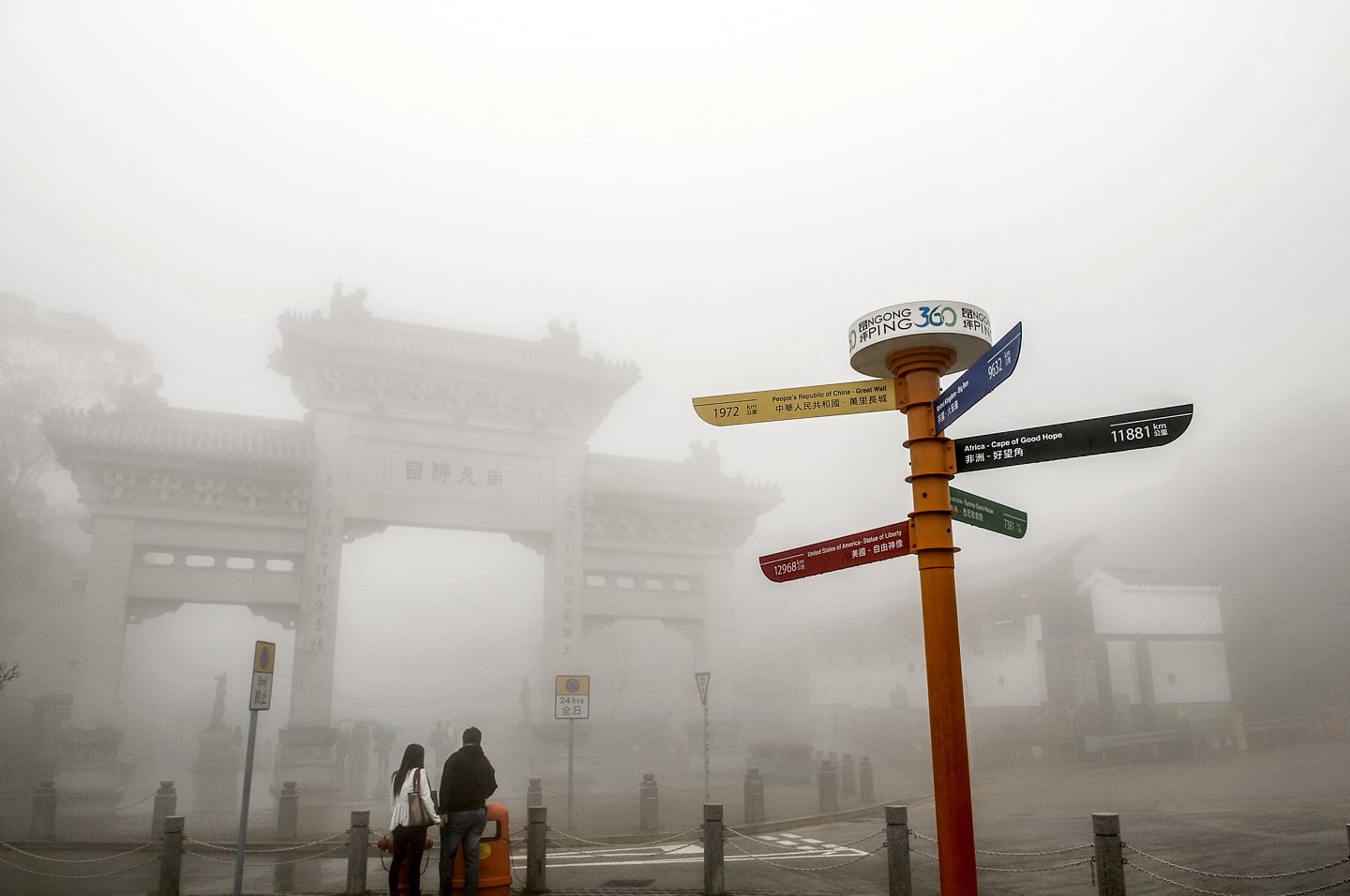
Our Tian Tan Buddha Trip Report
We visited Hong Kong in early December. Temperatures were chilly but comfortable.
The Big Buddha sits high upon a hill in Lantau’s interior and can be seen from as far away as Macau on a clear day (as you might expect from a 10-story bronze statue sitting atop a hill of 268 steps).
This, however, was not a clear day. More on that in a moment.
On the plus side, the fog did help to dramatically reduce the number of visitors to the Big Buddha, which is huge given the popularity of the site.
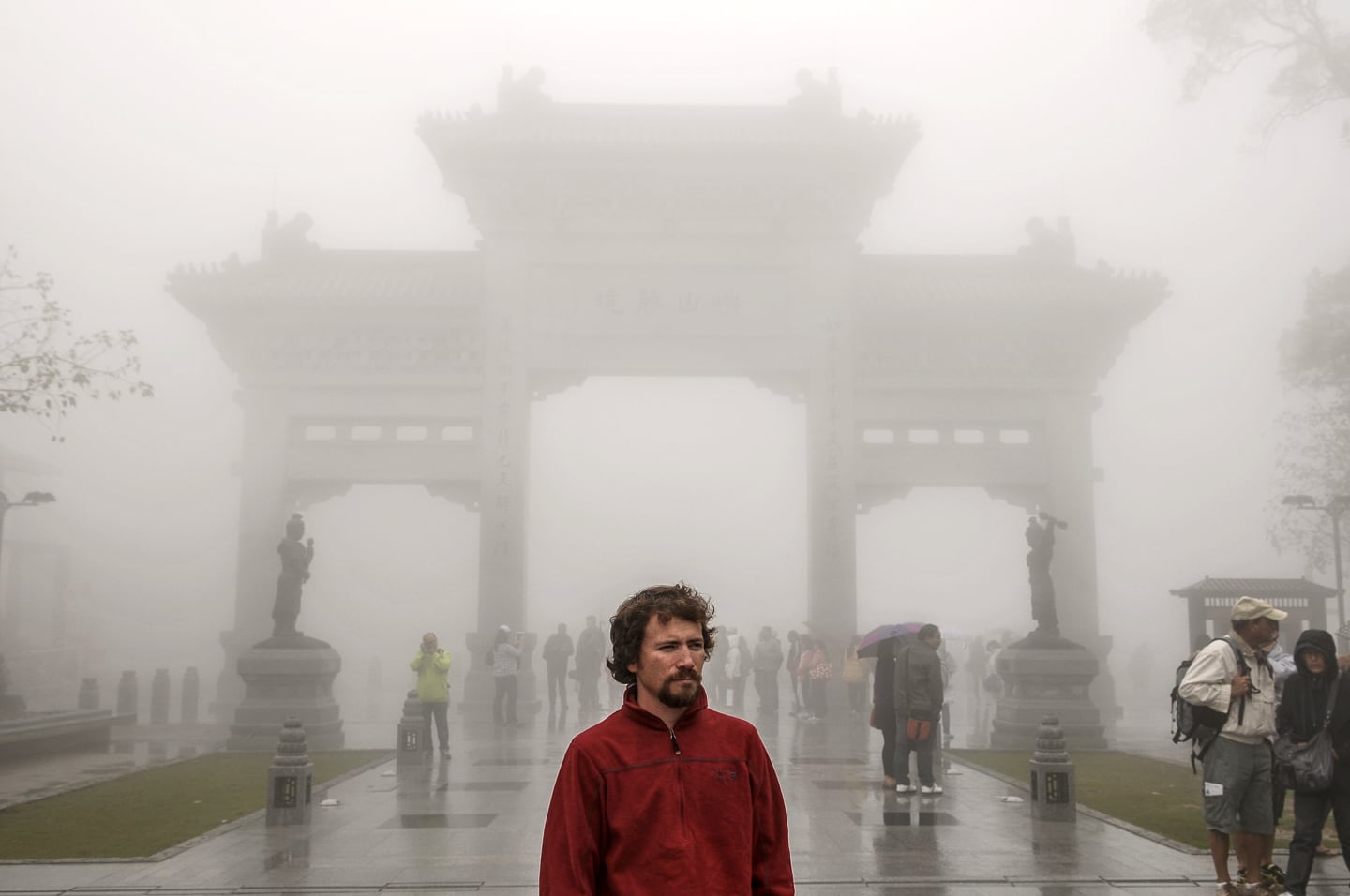
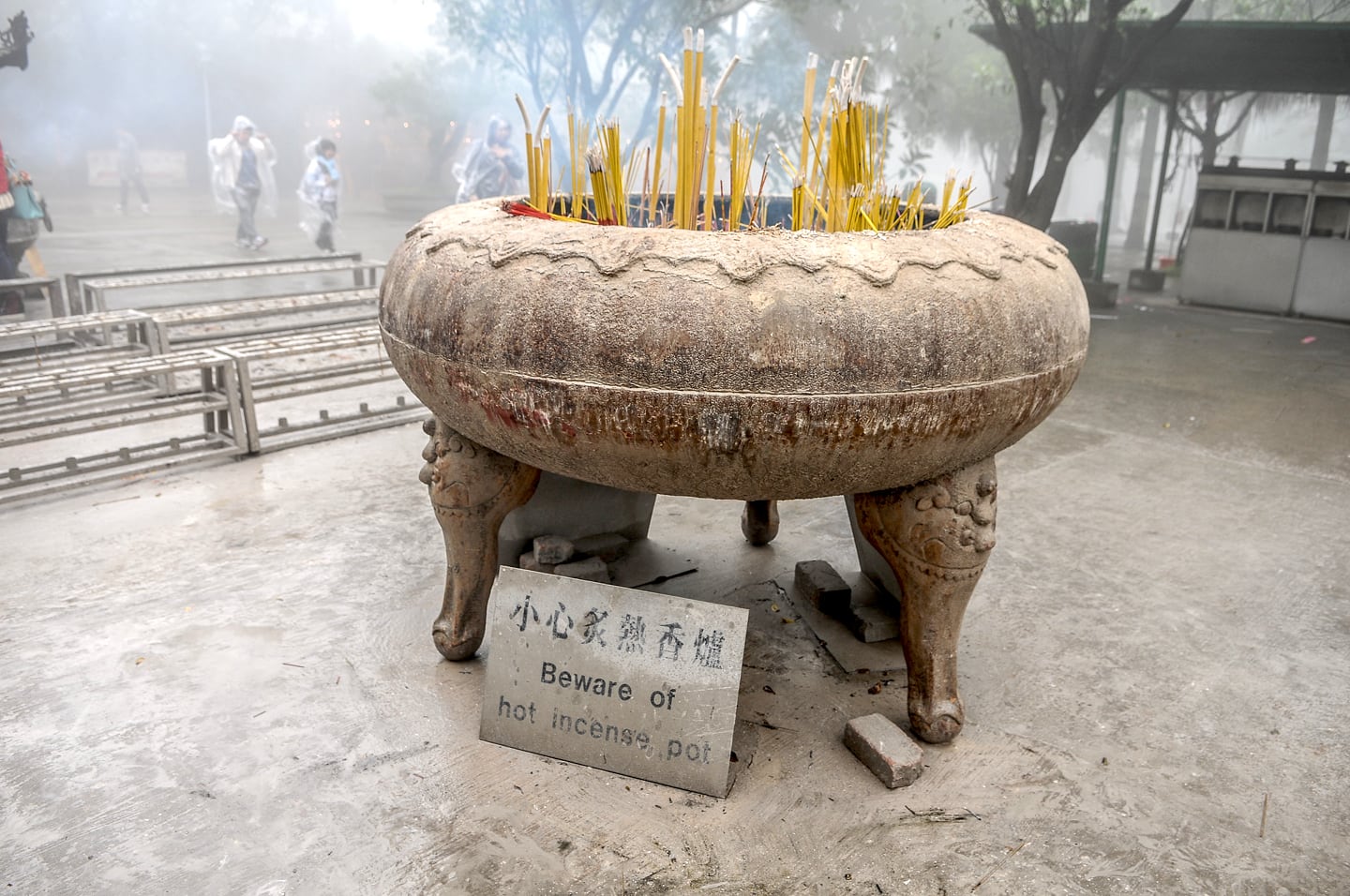
The Hong Kong Big Buddha has become one of the area’s biggest tourist attractions, so it’s sometimes easy to forget that the complex is an important place of worship for many.
Be respectful and plan accordingly.
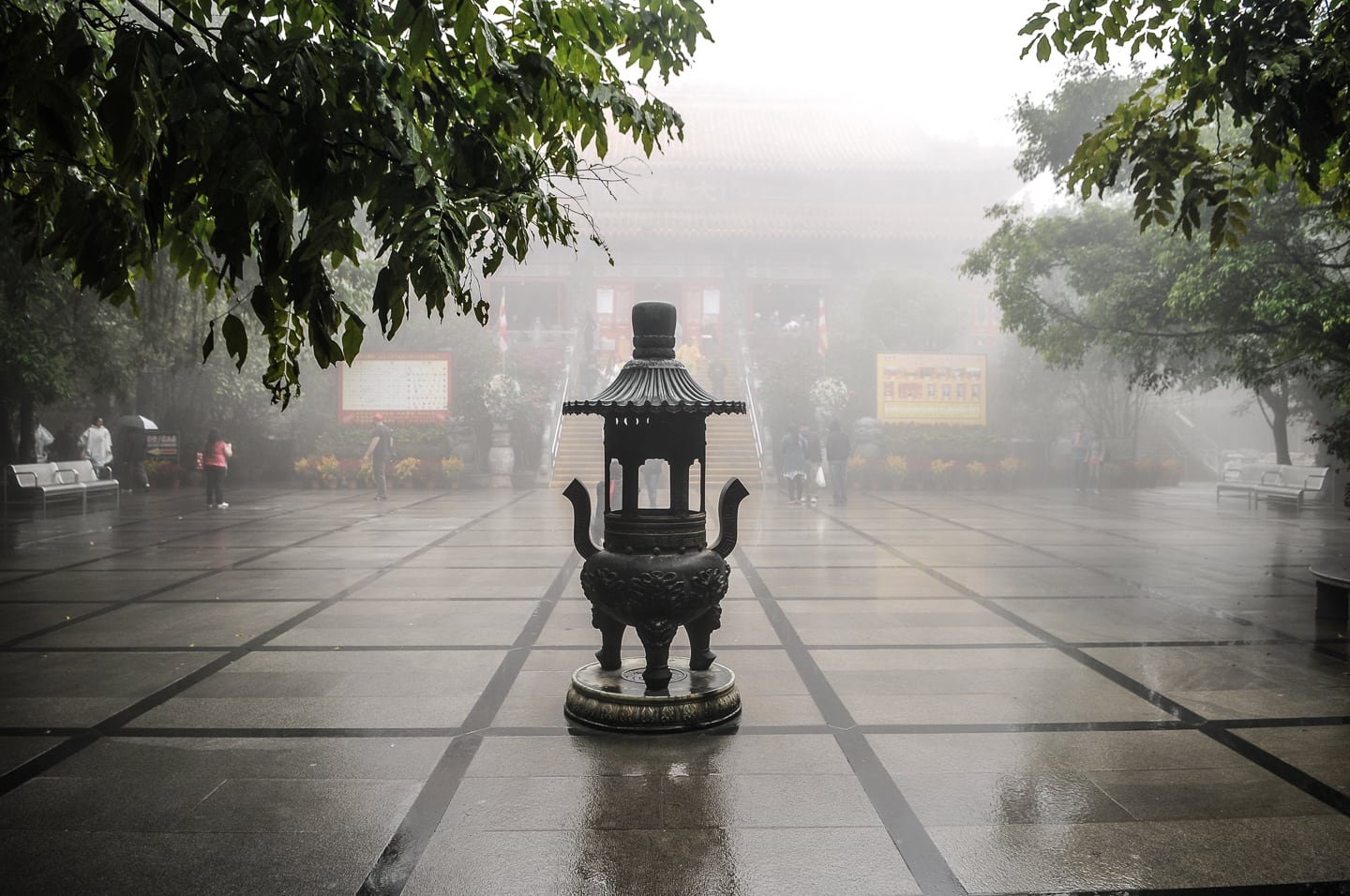
Po Lin Monastery
The Hong Kong Big Buddha shares the site with a sprawling pavilion complex, the Po Lin Monastery, which was lovely in its own right — even on a dreary day.
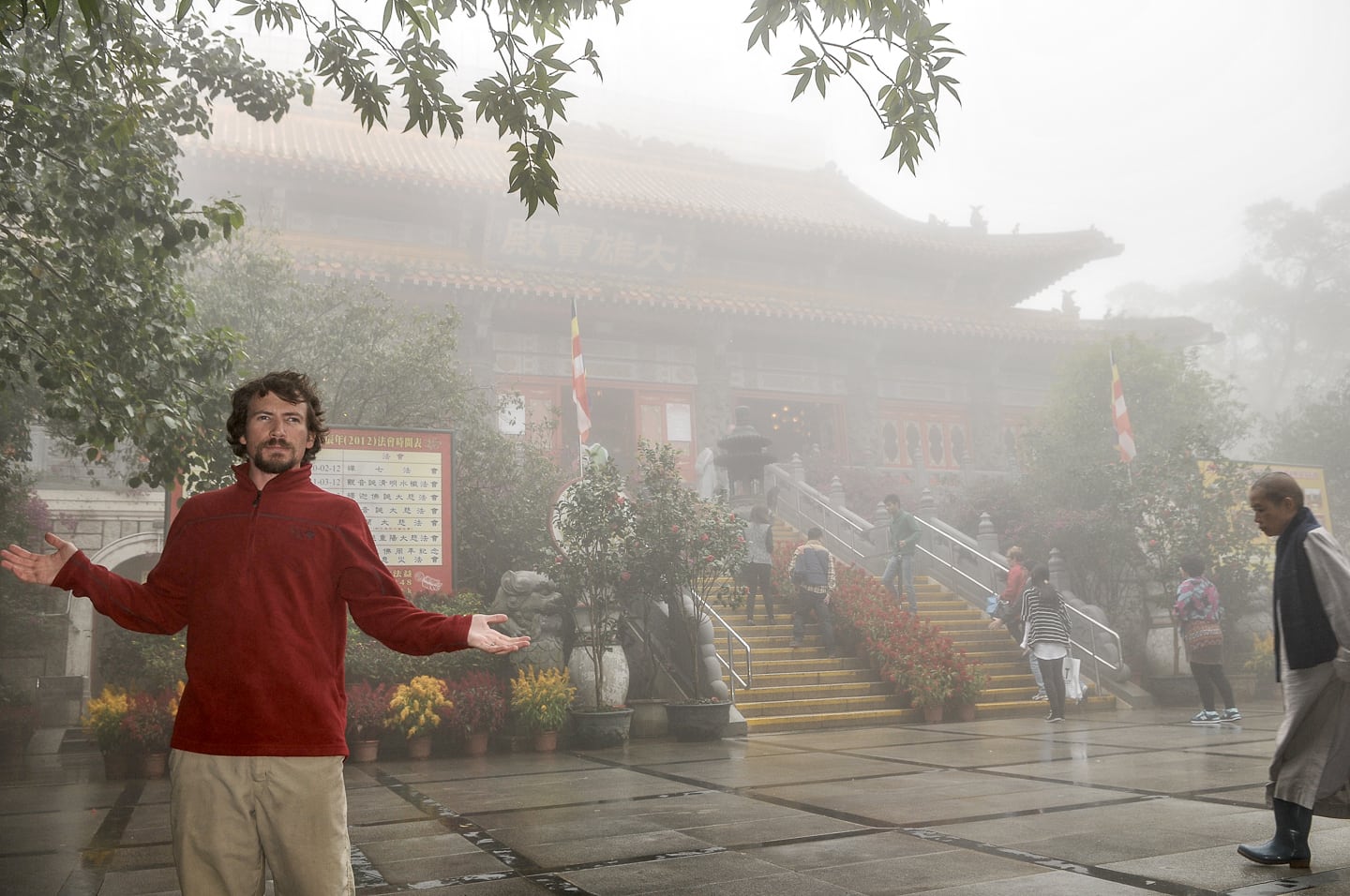
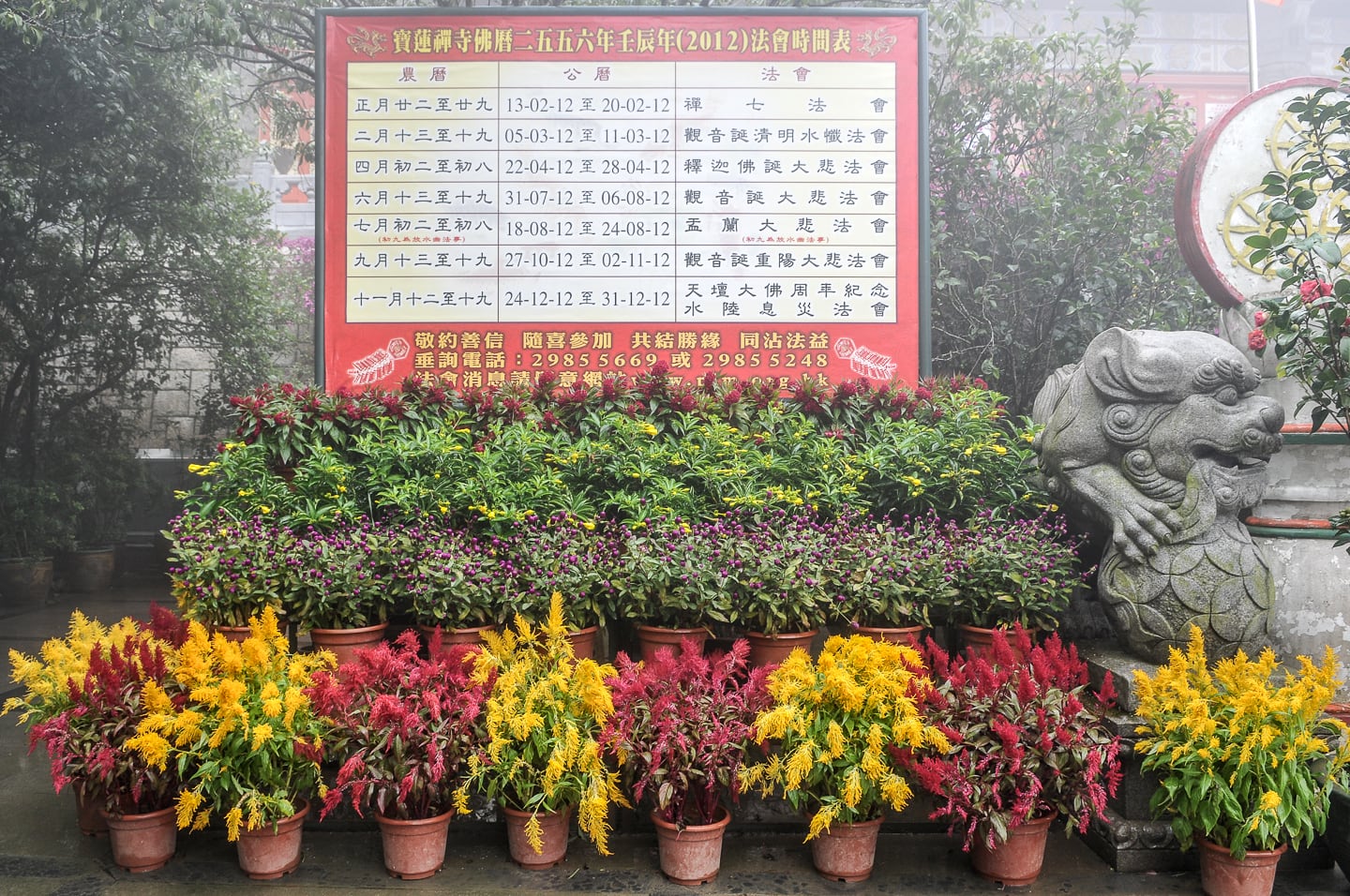
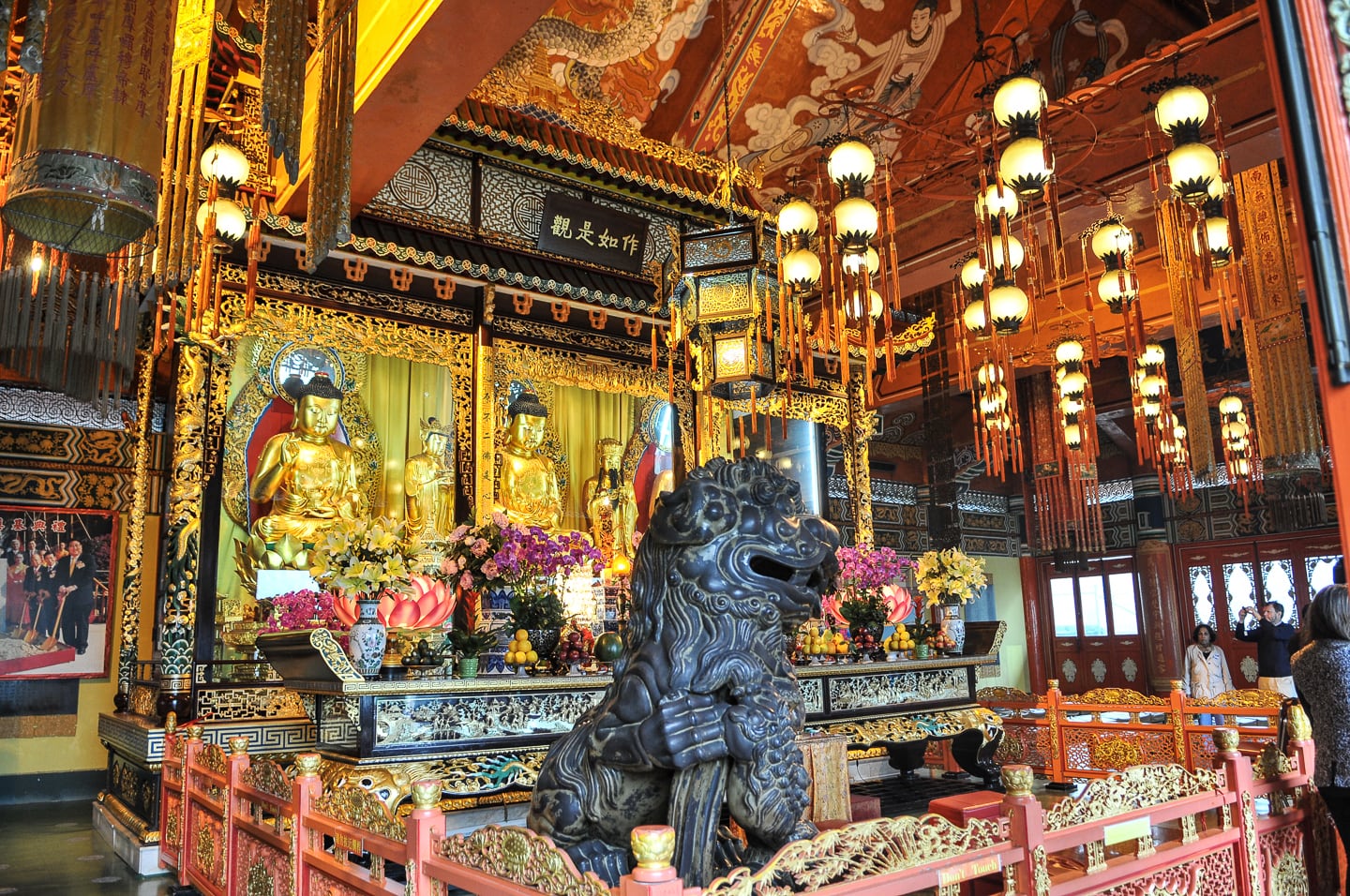
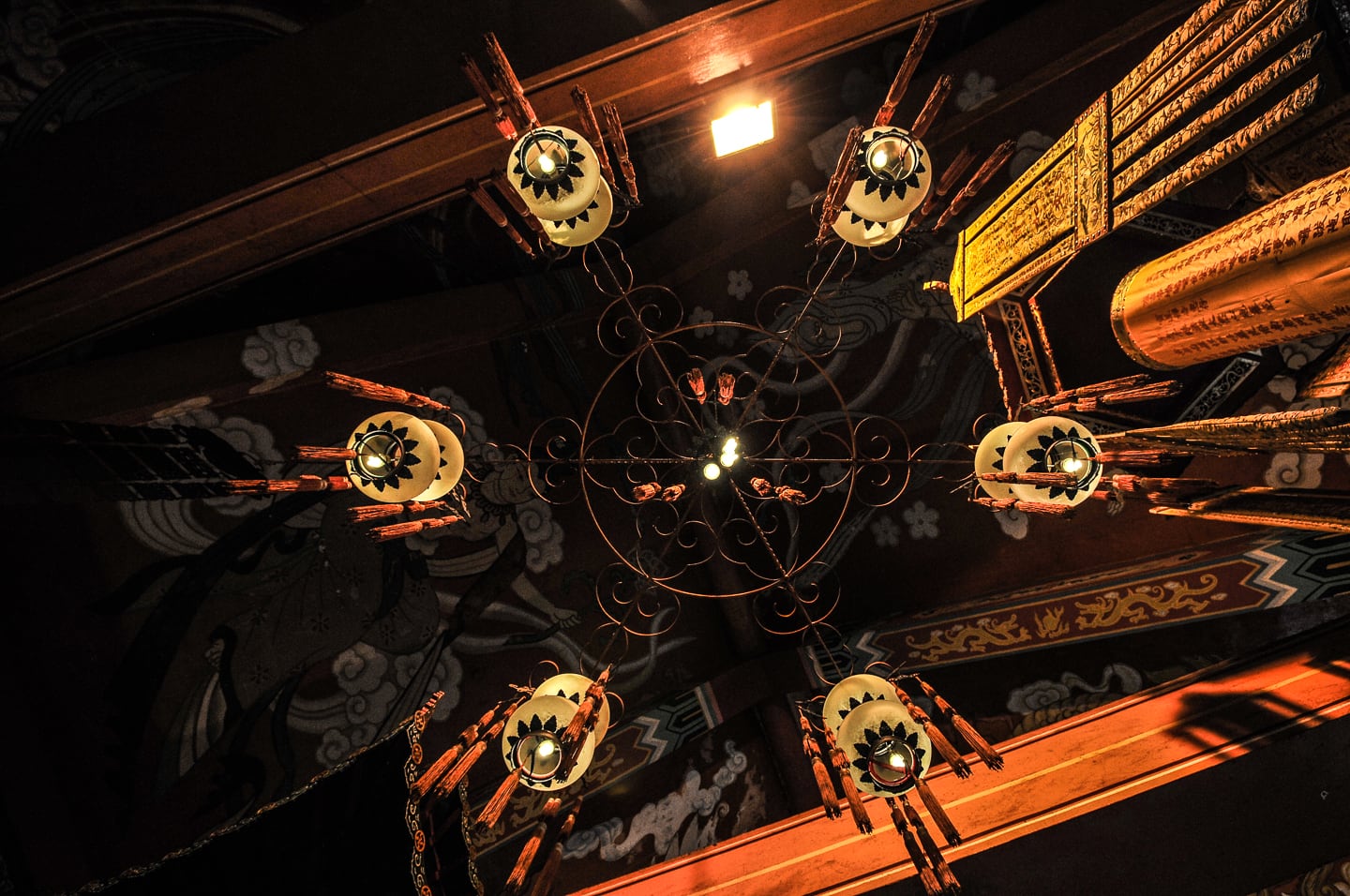
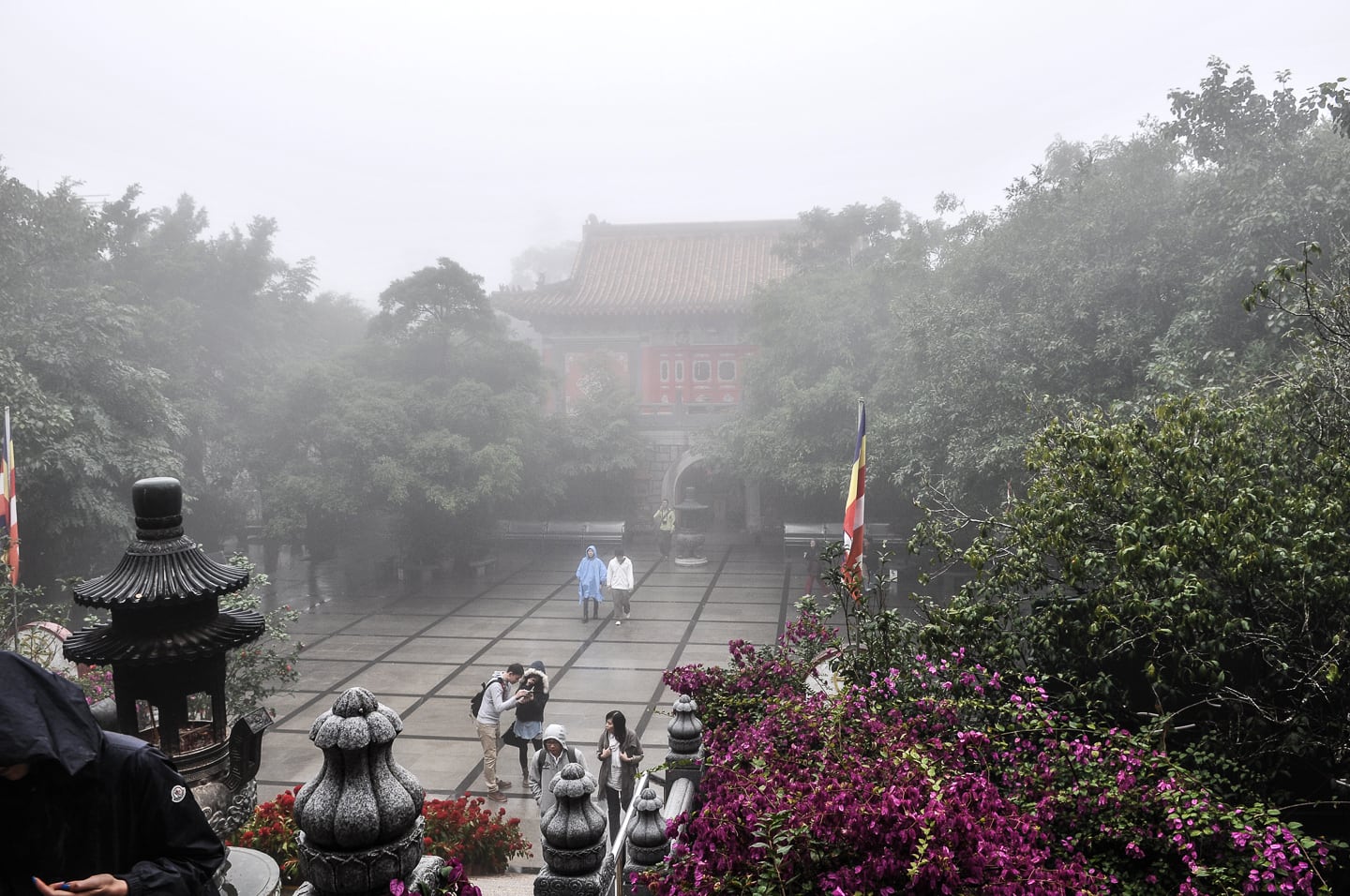
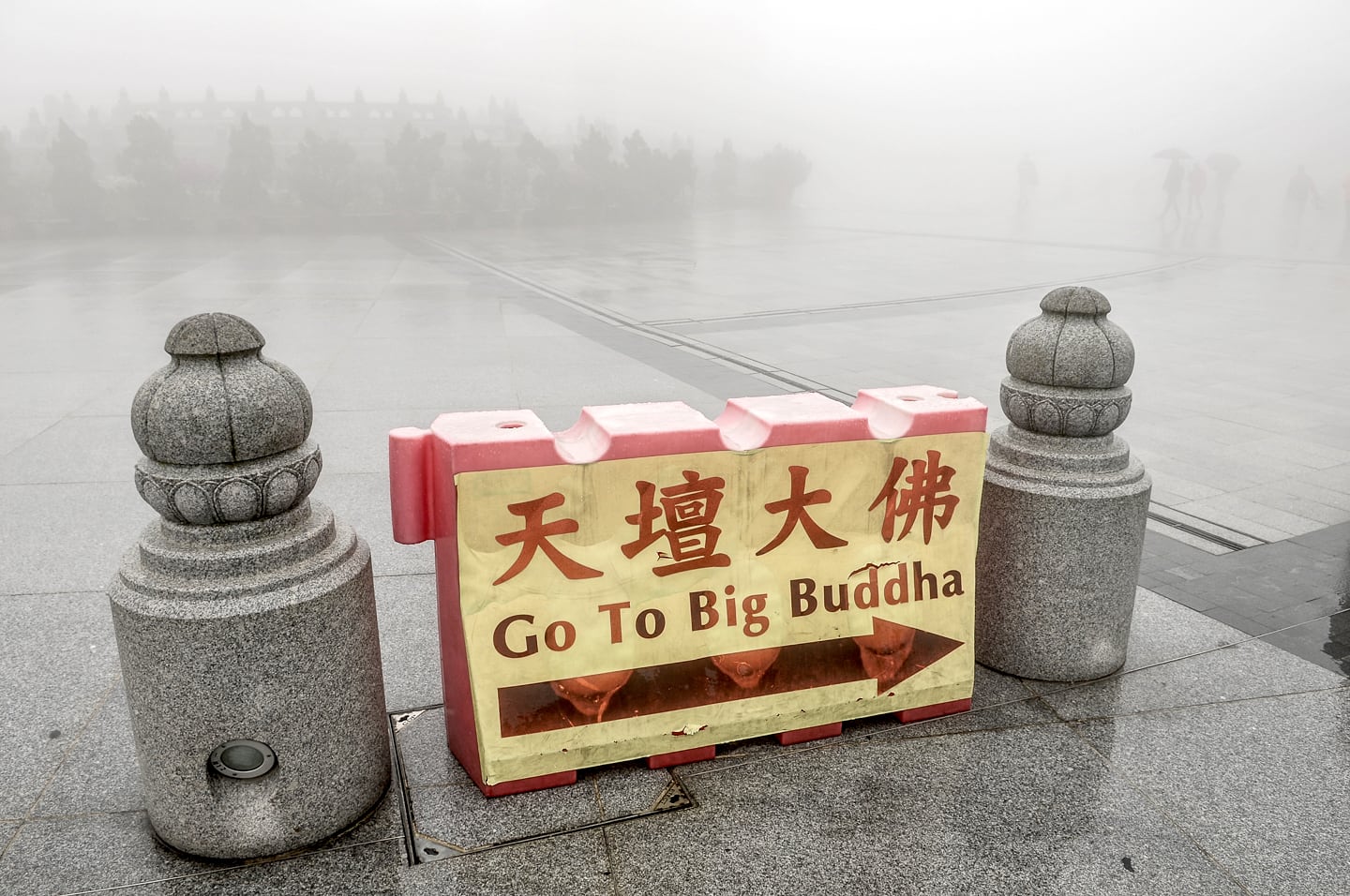
Enough already! On to the Big Buddha!
…and, which way might that be again? Ah, right!
Ascending the Stairs to Big Buddha
Construction of the Tian Tan Buddha began in 1990 and was completed on 29 December 1993, which marks the anniversary of the day the original Buddha achieved enlightenment.
The Buddha faces north, which makes this statue unique, as great Buddha statues generally face south.
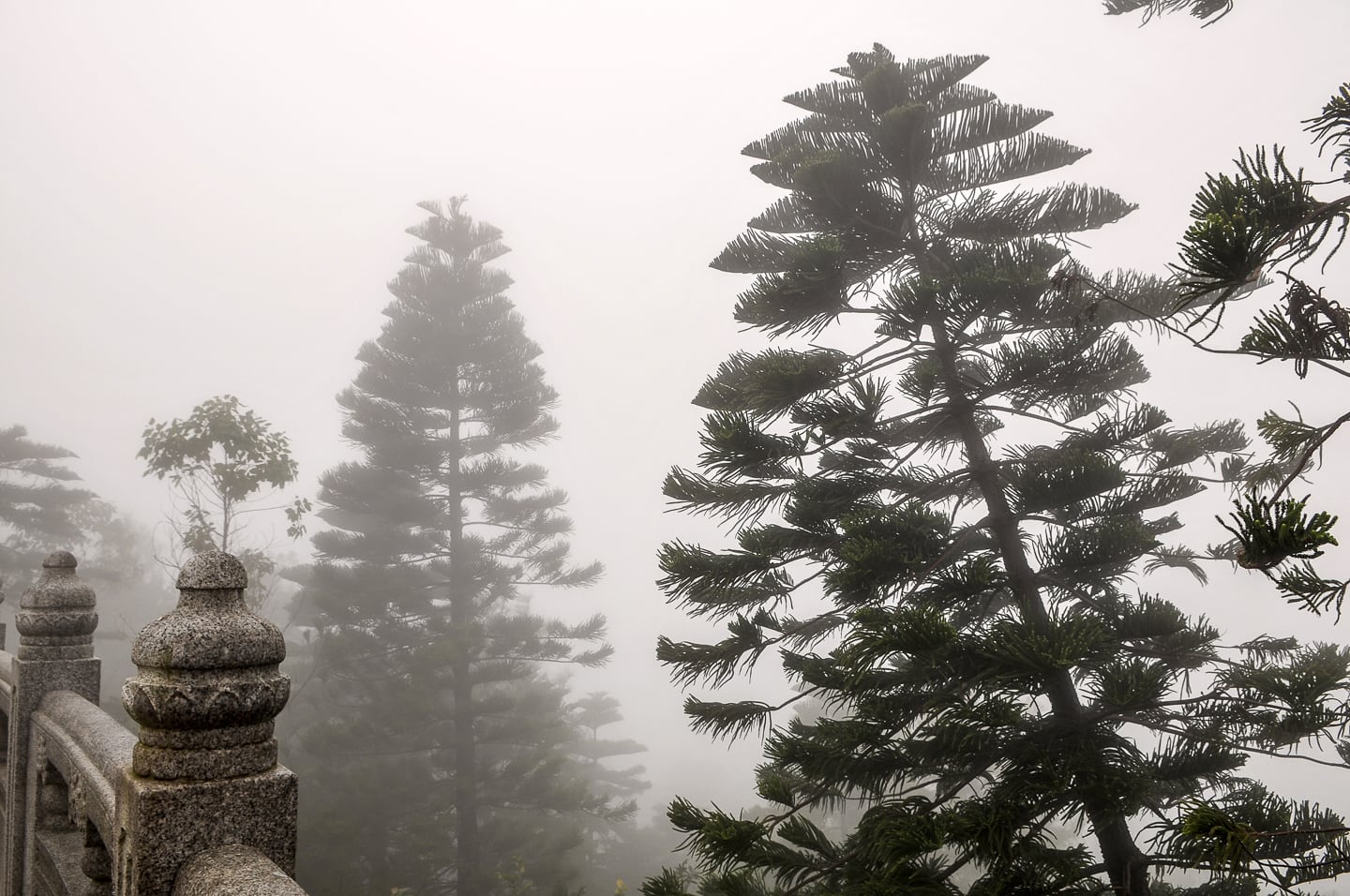
Climbing the steps and still not seeing the massive Buddha likeness, but we know he’s around here somewhere… 234…235…236…
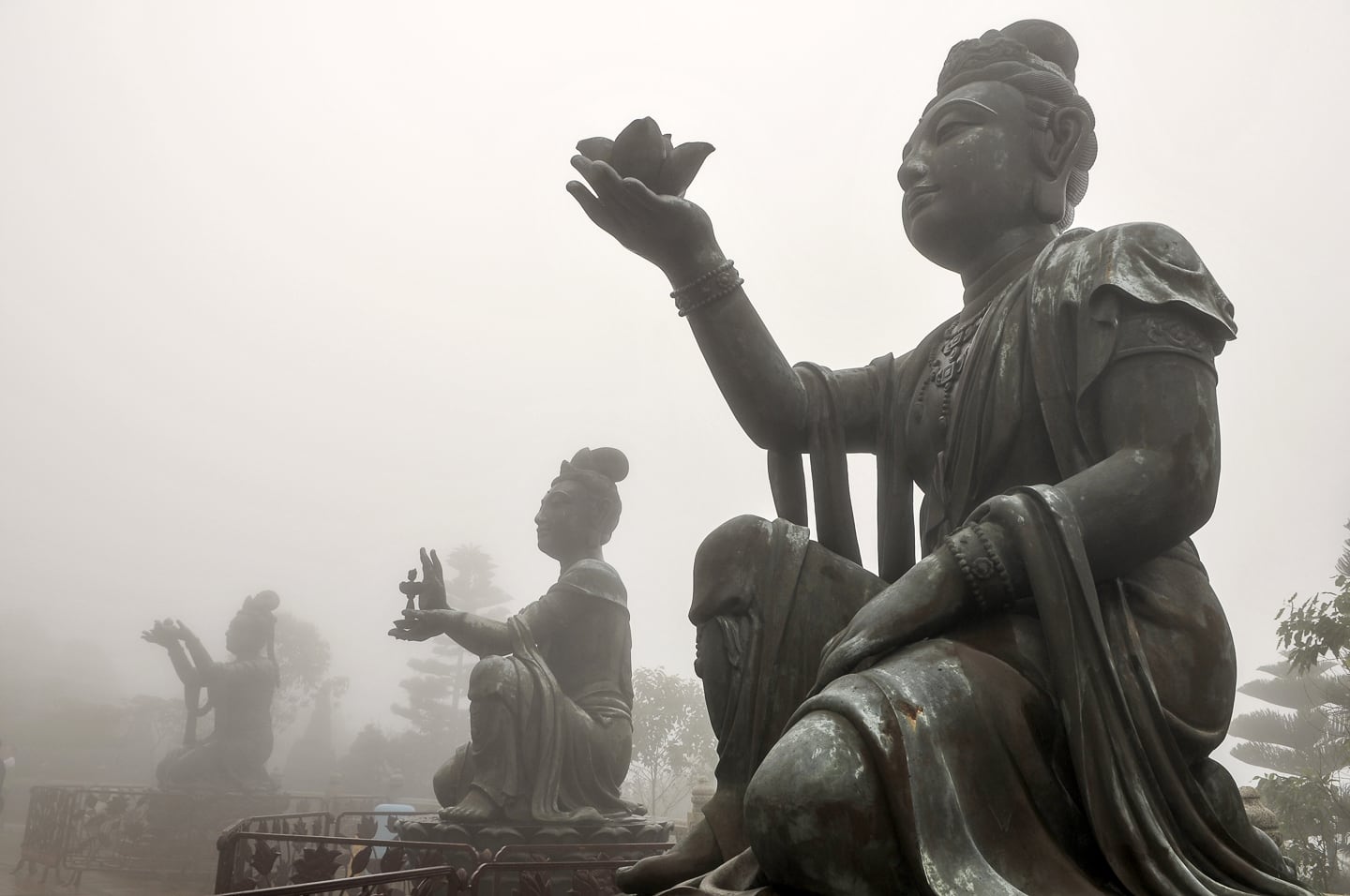
The Buddha is ringed by six smaller statues known as the “Offering of the Six Devas”
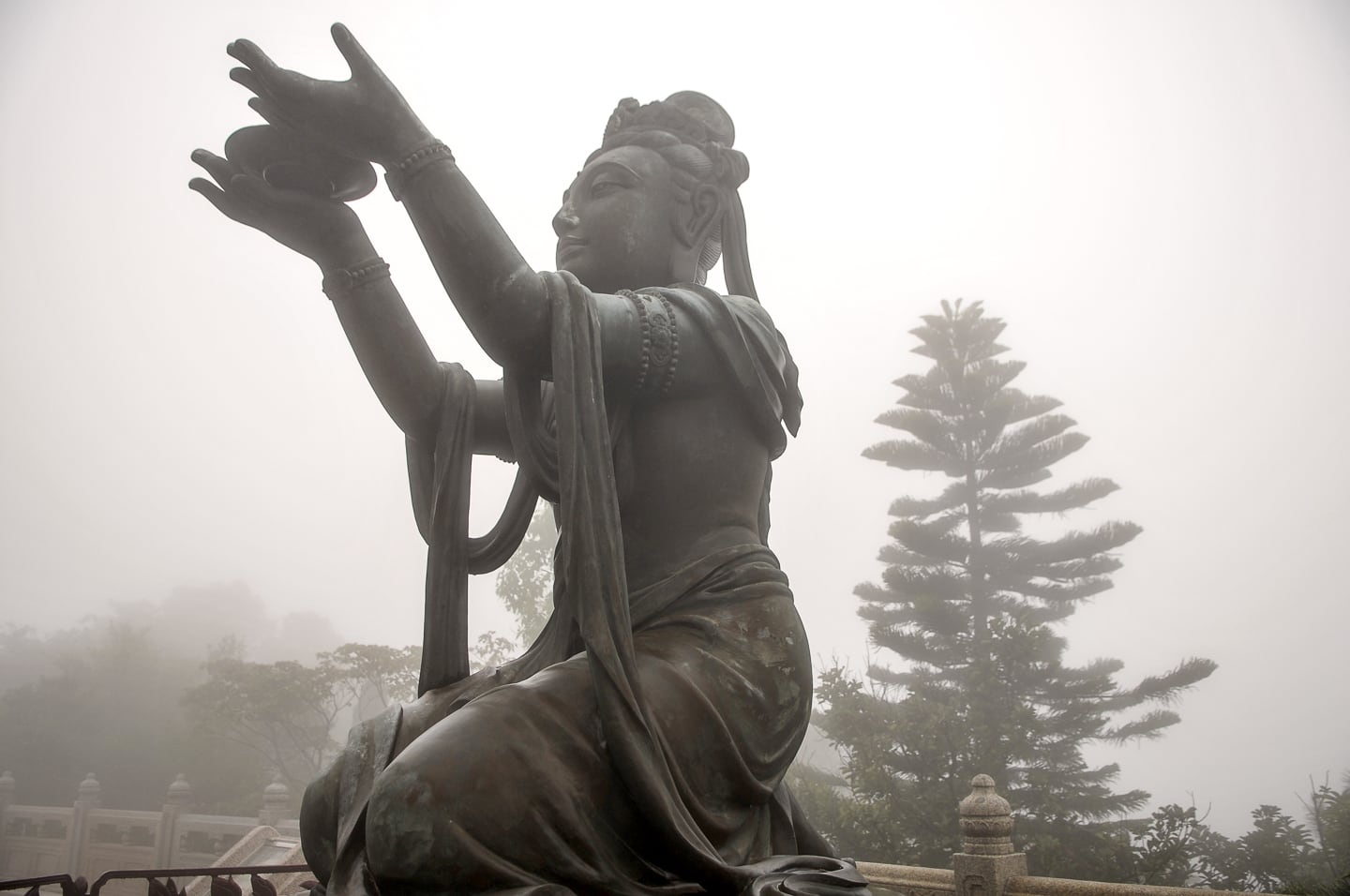
Finally, after climbing 268 steps the magnificent Tien Tan Buddha comes into focus…well, not exactly.
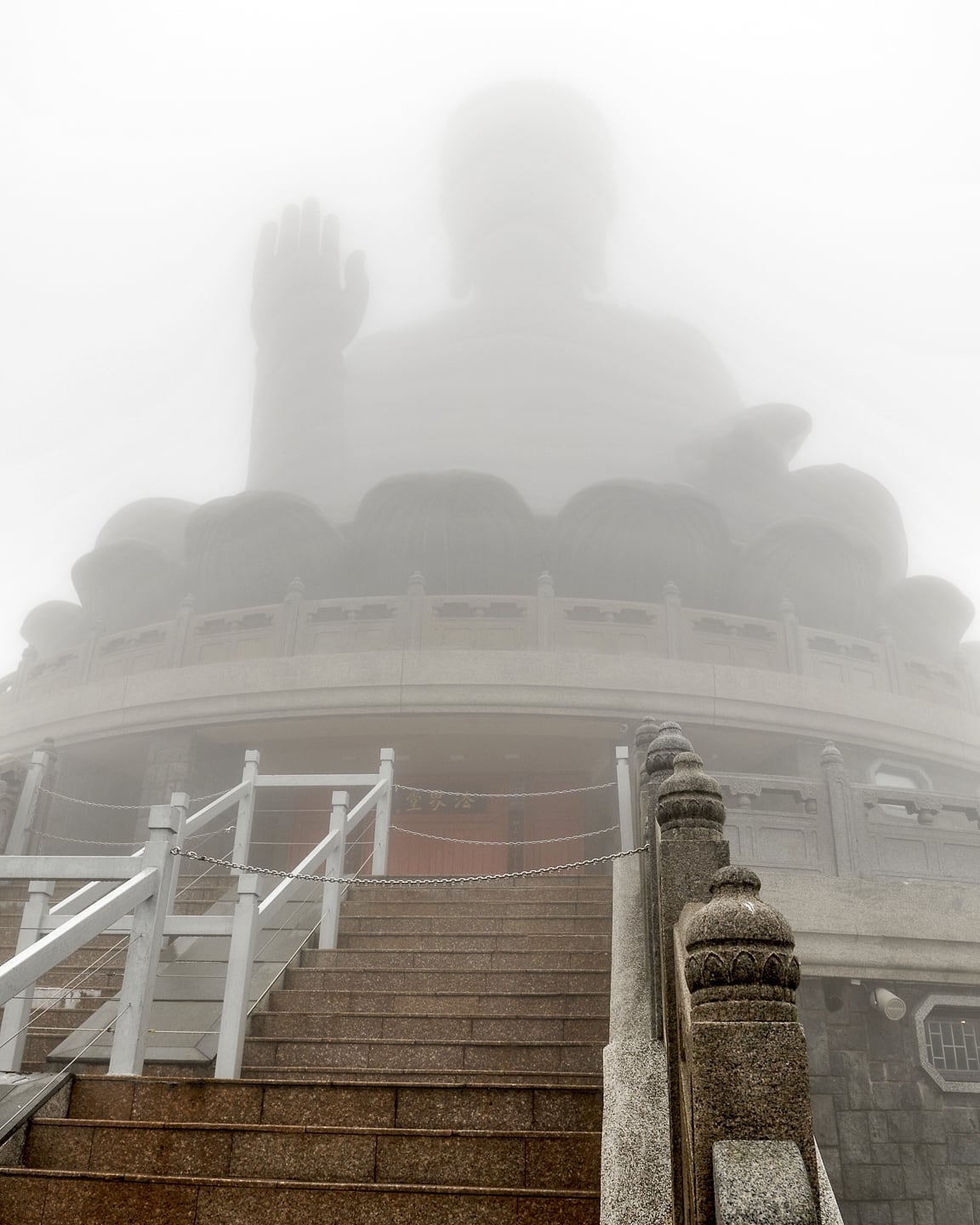
Is that you Big Buddha?
“Hi, Guys…”
And then all of a sudden the earth begins to move and the clouds part and…
…TA DA!
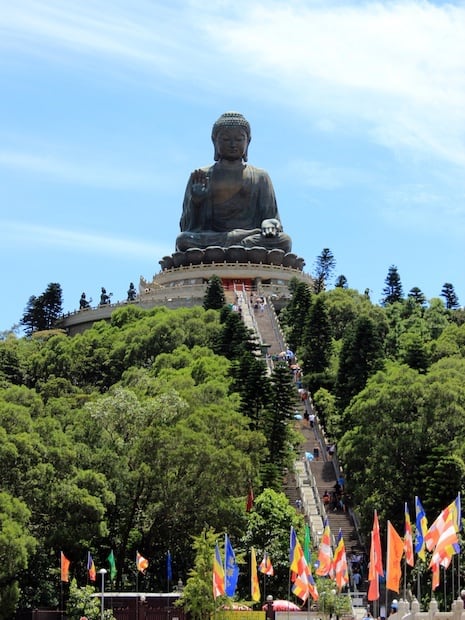
Yeah…not so much today.
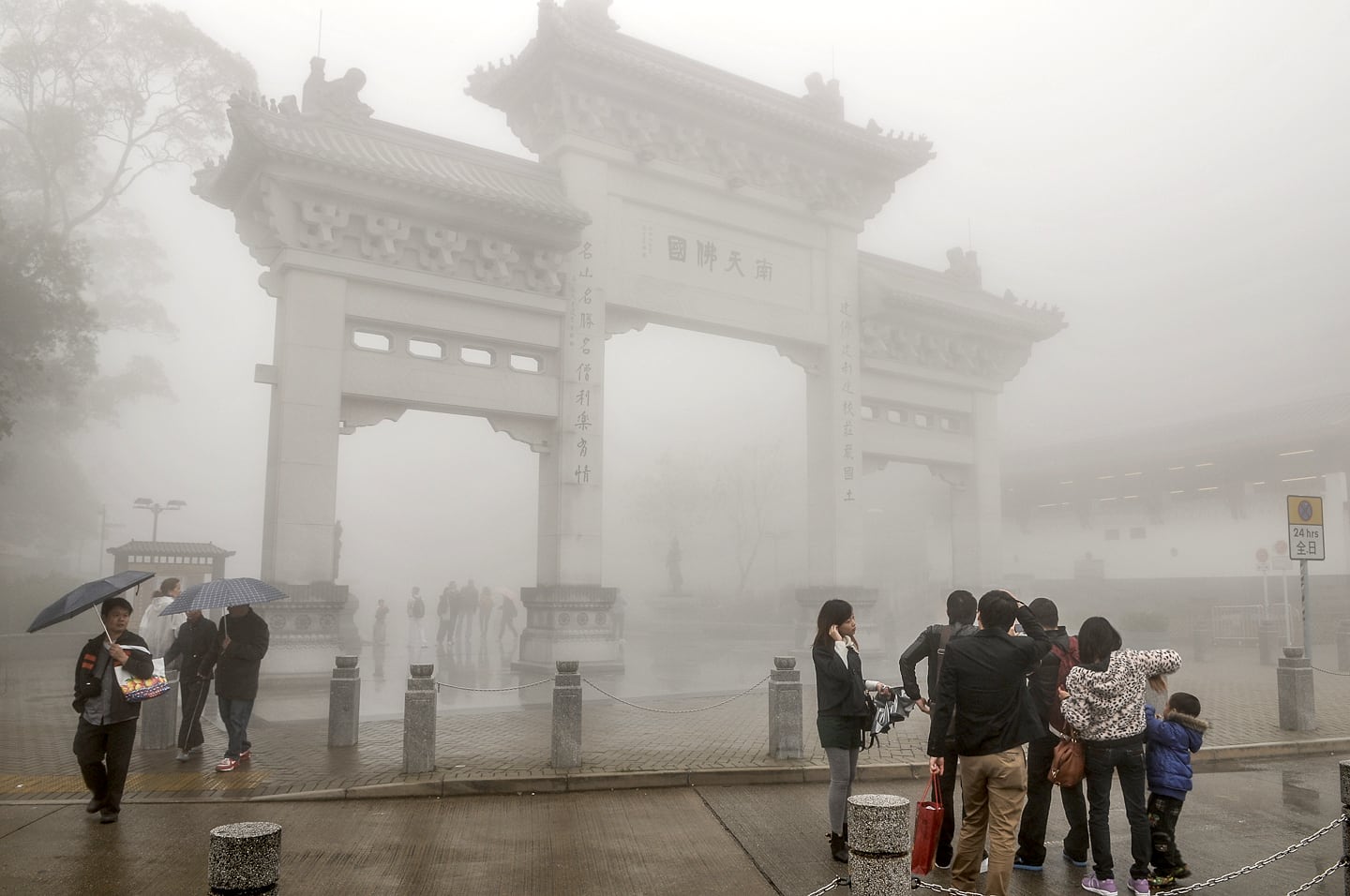
Ngong Ping Village
An entire tourist village has sprung up at the foot of Hong Kong Big Buddha called Ngong Ping Village.
But don’t be fooled!
While the village is built in the classical style, it is a very recent addition specifically aimed at meeting the growing influx of domestic and international visitors to the Hong Kong Big Buddha complex.
Ngong Ping offers everything you’d expect from a wholly commercial endeavor meant to satisfy the insatiable material needs of today’s growing tourist masses, such as gift shops, interpretive exhibitions, and an array of dining options (including…um…Starbucks and Subway…).
Our advice is to skip the eateries at Ngong Ping and eat inside Po Lin monastery.
The village also offers an informational film on the life of the Buddha, which might be a good place to start, depending on your personal knowledge of Siddhartha Gautama.
Traveling with Kids to Hong Kong Big Buddha
I know a lot of you with little ones might be going ‘woohoo!’ to the prospect of getting to Big Buddha faster and more efficiently via the new Cable Car.
My personal advice?
Don’t take the easy road just for the sake of avoiding a bit of discomfort. You’ve made it this far, and Lantau is a truly fun and interesting place to explore on your own. Give your family plenty of time to explore and get around by yourself.
Not going on an organized tour (or jetting there and back via MTR/cable car) doesn’t mean not planning ahead.
Get your hands on the local bus schedule and get lost! Even with kids.
The beauty of Hong Kong is the worst that will likely happen is the experience will lead to a bit of unexpected interaction with locals and memories that will last a lifetime.
If your family is into hiking, there are dozens of kilometers of paths around the Big Buddha complex to explore.
There are also a number of fascinating villages on the island to poke around in as well. Getting out of the tourist areas and exploring the neighboring communities was the highlight of our day trip.
